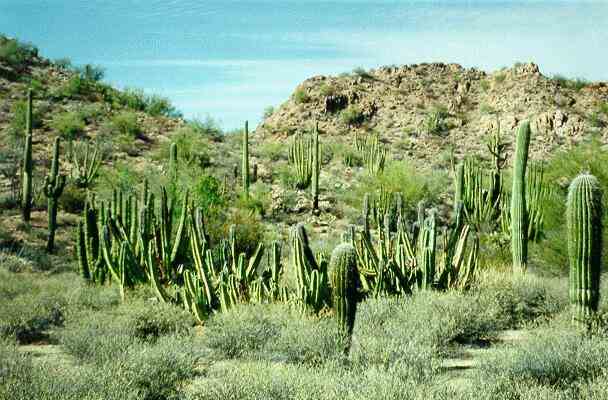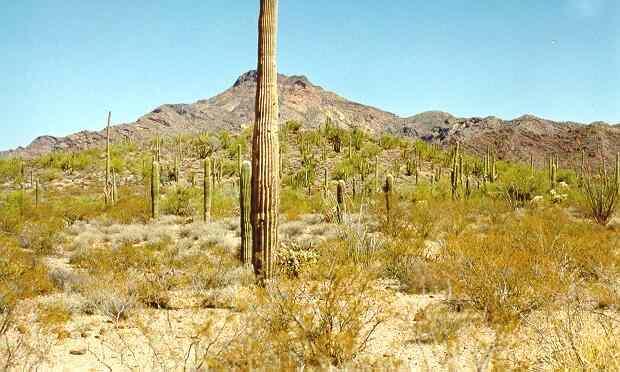| BAJADAS Bajadas are shallow slopes that lie at the base of rocky hills, where materials accumulate from the weathering of the rocks. They typically have a mixture of boulders, stones, gravel, sand and silt particles, creating a deep and complex soil structure that retains water and supports a rich vegetation.
In the example shown above - part of the Organ Pipe Cactus National Monument in the south of Arizona - the annual rainfall is as much as 30 cm per year and (an important point) it occurs in two distinct periods - during late winter and also during summer. This means that the area can support an unusually lush vegetation. Even so, all these plants are specially adapted to withstand periods of drought stress. The cacti have succulent tissues for water storage. We see four of the larger cacti here - the jumping cholla or chainfruit cholla (Opuntia fulgida. labelled 1), the Arizona barrel cactus (Ferrocactus wislizenii, labelled 2), the saguaro cactus (Carnegiea gigantea, labelled 4) and the organ pipe cactus (Stenocereus thurberi, labelled 5). We also see two plants which for most of the year have photosynthetic stems instead of leaves (an adaptation for restricting water-loss): the ocotillo (Fouquieria splendens, labelled 6) and a small tree - the foothill palo verde (Cercidium microphyllum, labelled 3). However, most of the ground is covered by a less conspicuous perennial shrub - the low-growing, grey-green plant called triangle-leaf bursage (Ambrosia deltoidea, labelled 7). This has hair-covered leaves to minimise water loss, and they are shed in periods of drought.
In desert regions, even small differences in slope or in soil type can have a dramatic effect on the vegetation - an effect that we don't often see in less harsh environments such as oak or pine woodlands, For example, the image above (again part of the Organ Pipe Cactus National Monument) shows how foothill palo verde (the bright green tree) is restricted to the upper part of a bajada. Then there is a band of large cacti, including the organ pipe cactus, the saguaro and the old man cactus (or senita, Lophocereus schottii), and in the foreground these have been replaced by bursage where the slope levels off. A similar transition is seen in the image below, where the large cacti are seen on the upper slopes of a bajada, and a mixture of bursage and creosote bush dominates the flatter part of the slope (foreground). The large saguaro cactus in the forground is clearly unhealthy - possibly due to frost damage.
Another type of transition is seen in the image below, where the land at the foot of a bajada is flat and consists mainly of silt and sand. In this case the soil is calcareous and subject to intense evaporation of water from the surface, leading to a high surface salt content. An occasional large cholla cactus (e.g. the jumping cholla, in the centre) or mesquite tree (far right) can occur in such regions but the dominant plants are saltbush (the grey-green shrub, Atriplex polycarpa) and a low-lying cholla cactus - the devil club (foreground, Opuntia stanlyi and related species). These are among the few plants that thrive in salty, alkaline conditions. As the land starts to rise in the middle distance we see a green zone of palo verde and saguaro cactus.
|



